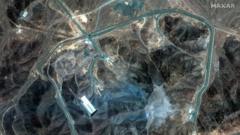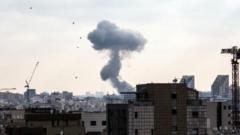Satellite images show the U.S. targeting key structures at Iran's Fordo nuclear facility, with experts indicating potential vulnerabilities in ventilation shafts. The damage to the site remains under assessment by U.S. and Israeli militaries.**
U.S. Targets Fordo Nuclear Facility: Satellite Evidence Unveiled**

U.S. Targets Fordo Nuclear Facility: Satellite Evidence Unveiled**
Recent satellite imagery reveals U.S. strikes on Iran's Fordo nuclear site, focusing on ventilation shafts, raising concerns about damage assessments.**
Satellite images taken post-U.S. strikes indicate definitive actions against Iran's Fordo nuclear enrichment facility, particularly targeting areas speculated to be ventilation shafts. An analysis by experts noted that ventilation shafts, once visible in satellite images from 2009, were likely vital air conduits for the facility during its construction but had since been buried by 2011. The U.S. military's airstrike involved six B-2 bombers that unleashed a dozen high-capacity "bunker buster" bombs on the complex.
Mark Fitzpatrick, a nuclear weapons specialist at the International Institute for Strategic Studies, commented, “Striking a ventilation shaft targets the foundation, breaching its structural integrity.” Another nuclear expert, Scott Roecker, stated that these shafts are indeed the facility's most vulnerable points.
As uncertainty looms over the extent of the damage, initial reports from President Trump claimed that Iran's nuclear capabilities were "completely and totally obliterated." In contrast, preliminary evaluations from U.S. and Israeli defense forces suggested that while the facility had suffered significant harm, it might not be wholly incapacitated. As assessments are ongoing, experts like Joseph Rodgers from the Center for Strategic and International Studies suggest that U.S. intelligence likely indicated the shafts’ weaknesses, guiding the strike.
Subsequent satellite imagery captured by Maxar Technologies depicted debris scattered across the facility grounds while support structures appeared relatively unharmed, leading experts to speculate that the objective was to undermine the underground operations rather than dismantling surface-level infrastructures. The aerial reconnaissance also revealed signs of pre-emptive measures by Iran, such as activity near the facility’s entrance tunnel before the attack.
Less than a week prior to the strikes, satellite images highlighted the presence of 16 cargo trucks clustered near a tunnel entrance, which quickly dispersed towards the northwest by June 20. Following the strikes, significant amounts of freshly disturbed soil around tunnel entrances were recorded, signifying possible efforts by Iran to fortify the site in anticipation of air assaults.






















